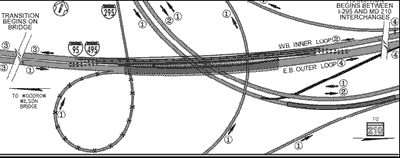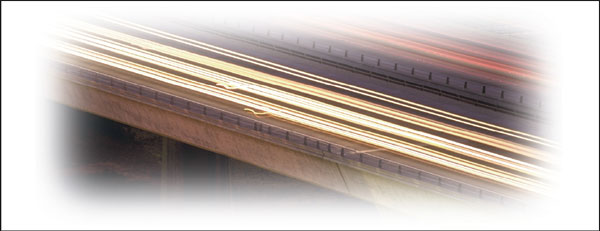U.S. Department of Transportation
Federal Highway Administration
1200 New Jersey Avenue, SE
Washington, DC 20590
202-366-4000
Federal Highway Administration Research and Technology
Coordinating, Developing, and Delivering Highway Transportation Innovations
 |
| This report is an archived publication and may contain dated technical, contact, and link information |
|
Publication Number: FHWA-HRT-05-143
Date: August 2005 |
PDF files can be viewed with the Acrobat® Reader®

Maintaining roadway capacity is an important aspect in the ongoing Woodrow Wilson Bridge replacement project in the Washington, DC metropolitan area. Lane closures are conducted only at night to minimize impact on road users. In the fall of 2001, a contractor for the Maryland State Highway Administration was in the process of constructing one of many new bridges as part of the project at the MD 210/ I-295/I-95 interchange just east of the Potomac River shoreline. The plan included closing lanes during the overnight hours (12 a.m. to 4 a.m.) and was scheduled to take from 4 to 6 months to complete. When this phase of the roadwork began, it was clear the limited hours of lane closures were incompatible with required setup and takedown time.
Project engineers responded with a QuickZone analysis that included multiple scenarios for extending the lane closure duration time and the number of lanes closed. The results showed an insignificant difference for motorists if the lane closures began at 9 p.m. instead of the proposed 12 a.m. Opening all lanes by 5 a.m. would be sufficient to maintain traffic flow. As a result of this information the lanes were closed at 9 p.m. and reopened by 5 a.m. Consequently, total duration of the construction project was reduced from an estimated 6 months to 2 months, hence reducing the impact on motorists. Moreover, the increase in the contractor’s productive time (from 2.5 hours to 6 hours) resulted in better utilization of available resources and ultimately saved money on the overall construction project. QuickZone allowed the management team to easily test various work zone plan scenarios and determine the best compromise between the interests of the construction project and the public.
KEY OBSERVATIONS
QUICKZONE
Deborah Curtis
Federal Highway Administration (FHWA)
Operations, Research and Development
Integrated Product Team
202–493–3267
deborah.curtis@fhwa.dot.gov
CASE STUDY
Andrew Lessner
QuickZone Analyst
Maryland State Highway Administration
410–787–5864
alessner@sha.state.md.us
Jawad Paracha
Transportation Engineer
Maryland State Highway Administration
410–787–5891
jparacha@sha.state.md.us
